Katherine M. Collins
When Should We Orchestrate Multiple Agents?
Mar 17, 2025Abstract:Strategies for orchestrating the interactions between multiple agents, both human and artificial, can wildly overestimate performance and underestimate the cost of orchestration. We design a framework to orchestrate agents under realistic conditions, such as inference costs or availability constraints. We show theoretically that orchestration is only effective if there are performance or cost differentials between agents. We then empirically demonstrate how orchestration between multiple agents can be helpful for selecting agents in a simulated environment, picking a learning strategy in the infamous Rogers' Paradox from social science, and outsourcing tasks to other agents during a question-answer task in a user study.
General Scales Unlock AI Evaluation with Explanatory and Predictive Power
Mar 09, 2025Abstract:Ensuring safe and effective use of AI requires understanding and anticipating its performance on novel tasks, from advanced scientific challenges to transformed workplace activities. So far, benchmarking has guided progress in AI, but it has offered limited explanatory and predictive power for general-purpose AI systems, given the low transferability across diverse tasks. In this paper, we introduce general scales for AI evaluation that can explain what common AI benchmarks really measure, extract ability profiles of AI systems, and predict their performance for new task instances, in- and out-of-distribution. Our fully-automated methodology builds on 18 newly-crafted rubrics that place instance demands on general scales that do not saturate. Illustrated for 15 large language models and 63 tasks, high explanatory power is unleashed from inspecting the demand and ability profiles, bringing insights on the sensitivity and specificity exhibited by different benchmarks, and how knowledge, metacognition and reasoning are affected by model size, chain-of-thought and distillation. Surprisingly, high predictive power at the instance level becomes possible using these demand levels, providing superior estimates over black-box baseline predictors based on embeddings or finetuning, especially in out-of-distribution settings (new tasks and new benchmarks). The scales, rubrics, battery, techniques and results presented here represent a major step for AI evaluation, underpinning the reliable deployment of AI in the years ahead.
On Benchmarking Human-Like Intelligence in Machines
Feb 27, 2025Abstract:Recent benchmark studies have claimed that AI has approached or even surpassed human-level performances on various cognitive tasks. However, this position paper argues that current AI evaluation paradigms are insufficient for assessing human-like cognitive capabilities. We identify a set of key shortcomings: a lack of human-validated labels, inadequate representation of human response variability and uncertainty, and reliance on simplified and ecologically-invalid tasks. We support our claims by conducting a human evaluation study on ten existing AI benchmarks, suggesting significant biases and flaws in task and label designs. To address these limitations, we propose five concrete recommendations for developing future benchmarks that will enable more rigorous and meaningful evaluations of human-like cognitive capacities in AI with various implications for such AI applications.
Data for Mathematical Copilots: Better Ways of Presenting Proofs for Machine Learning
Dec 19, 2024

Abstract:The suite of datasets commonly used to train and evaluate the mathematical capabilities of AI-based mathematical copilots (primarily large language models) exhibit several shortcomings. These limitations include a restricted scope of mathematical complexity, typically not exceeding lower undergraduate-level mathematics, binary rating protocols and other issues, which makes comprehensive proof-based evaluation suites difficult. We systematically explore these limitations and contend that enhancing the capabilities of large language models, or any forthcoming advancements in AI-based mathematical assistants (copilots or "thought partners"), necessitates a paradigm shift in the design of mathematical datasets and the evaluation criteria of mathematical ability: It is necessary to move away from result-based datasets (theorem statement to theorem proof) and convert the rich facets of mathematical research practice to data LLMs can train on. Examples of these are mathematical workflows (sequences of atomic, potentially subfield-dependent tasks that are often performed when creating new mathematics), which are an important part of the proof-discovery process. Additionally, we advocate for mathematical dataset developers to consider the concept of "motivated proof", introduced by G. P\'olya in 1949, which can serve as a blueprint for datasets that offer a better proof learning signal, alleviating some of the mentioned limitations. Lastly, we introduce math datasheets for datasets, extending the general, dataset-agnostic variants of datasheets: We provide a questionnaire designed specifically for math datasets that we urge dataset creators to include with their datasets. This will make creators aware of potential limitations of their datasets while at the same time making it easy for readers to assess it from the point of view of training and evaluating mathematical copilots.
Can Large Language Models Understand Symbolic Graphics Programs?
Aug 15, 2024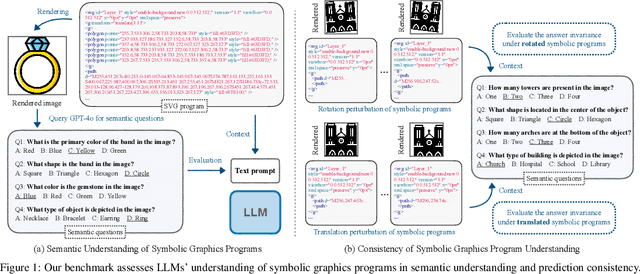

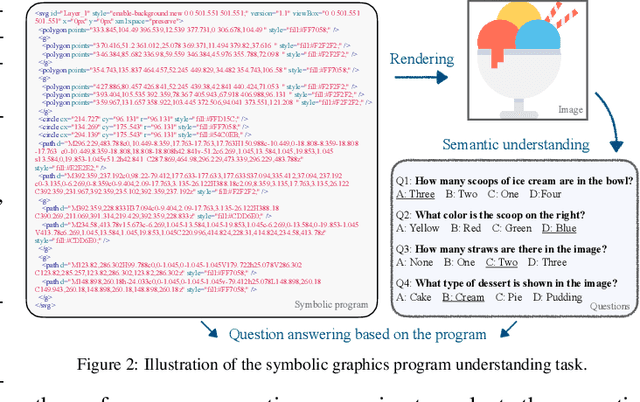
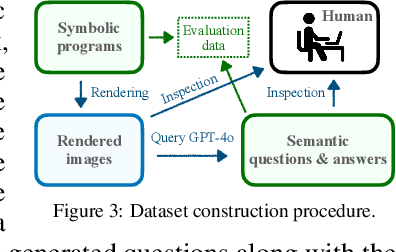
Abstract:Assessing the capabilities of large language models (LLMs) is often challenging, in part, because it is hard to find tasks to which they have not been exposed during training. We take one step to address this challenge by turning to a new task: focusing on symbolic graphics programs, which are a popular representation for graphics content that procedurally generates visual data. LLMs have shown exciting promise towards program synthesis, but do they understand symbolic graphics programs? Unlike conventional programs, symbolic graphics programs can be translated to graphics content. Here, we characterize an LLM's understanding of symbolic programs in terms of their ability to answer questions related to the graphics content. This task is challenging as the questions are difficult to answer from the symbolic programs alone -- yet, they would be easy to answer from the corresponding graphics content as we verify through a human experiment. To understand symbolic programs, LLMs may need to possess the ability to imagine how the corresponding graphics content would look without directly accessing the rendered visual content. We use this task to evaluate LLMs by creating a large benchmark for the semantic understanding of symbolic graphics programs. This benchmark is built via program-graphics correspondence, hence requiring minimal human efforts. We evaluate current LLMs on our benchmark to elucidate a preliminary assessment of their ability to reason about visual scenes from programs. We find that this task distinguishes existing LLMs and models considered good at reasoning perform better. Lastly, we introduce Symbolic Instruction Tuning (SIT) to improve this ability. Specifically, we query GPT4-o with questions and images generated by symbolic programs. Such data are then used to finetune an LLM. We also find that SIT data can improve the general instruction following ability of LLMs.
Building Machines that Learn and Think with People
Jul 22, 2024
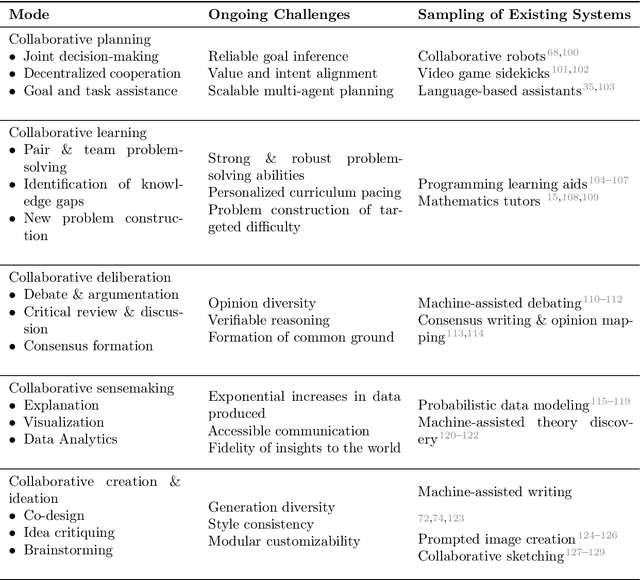
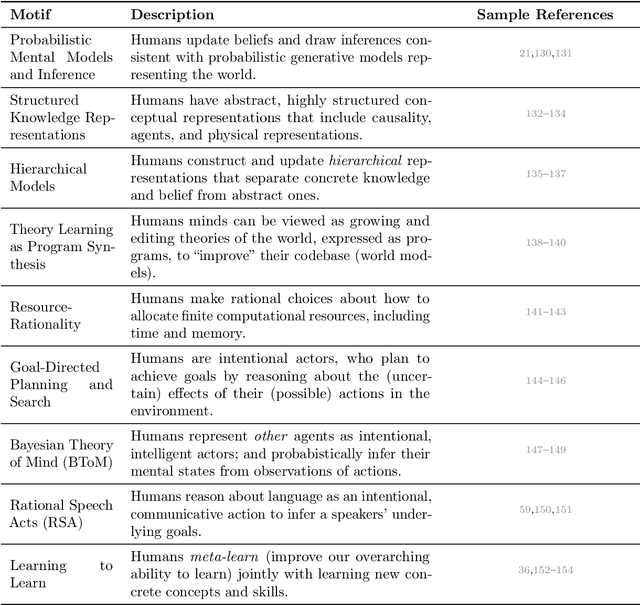
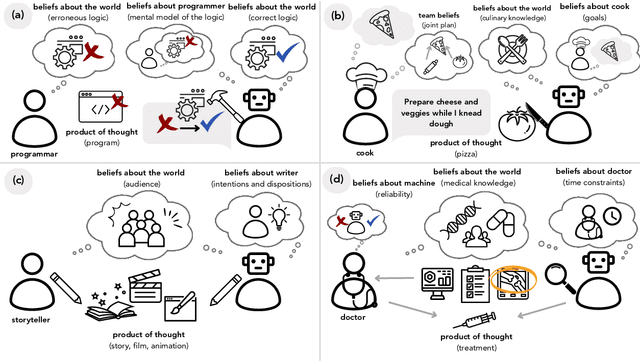
Abstract:What do we want from machine intelligence? We envision machines that are not just tools for thought, but partners in thought: reasonable, insightful, knowledgeable, reliable, and trustworthy systems that think with us. Current artificial intelligence (AI) systems satisfy some of these criteria, some of the time. In this Perspective, we show how the science of collaborative cognition can be put to work to engineer systems that really can be called ``thought partners,'' systems built to meet our expectations and complement our limitations. We lay out several modes of collaborative thought in which humans and AI thought partners can engage and propose desiderata for human-compatible thought partnerships. Drawing on motifs from computational cognitive science, we motivate an alternative scaling path for the design of thought partners and ecosystems around their use through a Bayesian lens, whereby the partners we construct actively build and reason over models of the human and world.
People use fast, goal-directed simulation to reason about novel games
Jul 19, 2024Abstract:We can evaluate features of problems and their potential solutions well before we can effectively solve them. When considering a game we have never played, for instance, we might infer whether it is likely to be challenging, fair, or fun simply from hearing the game rules, prior to deciding whether to invest time in learning the game or trying to play it well. Many studies of game play have focused on optimality and expertise, characterizing how people and computational models play based on moderate to extensive search and after playing a game dozens (if not thousands or millions) of times. Here, we study how people reason about a range of simple but novel connect-n style board games. We ask people to judge how fair and how fun the games are from very little experience: just thinking about the game for a minute or so, before they have ever actually played with anyone else, and we propose a resource-limited model that captures their judgments using only a small number of partial game simulations and almost no lookahead search.
Beyond Thumbs Up/Down: Untangling Challenges of Fine-Grained Feedback for Text-to-Image Generation
Jun 24, 2024Abstract:Human feedback plays a critical role in learning and refining reward models for text-to-image generation, but the optimal form the feedback should take for learning an accurate reward function has not been conclusively established. This paper investigates the effectiveness of fine-grained feedback which captures nuanced distinctions in image quality and prompt-alignment, compared to traditional coarse-grained feedback (for example, thumbs up/down or ranking between a set of options). While fine-grained feedback holds promise, particularly for systems catering to diverse societal preferences, we show that demonstrating its superiority to coarse-grained feedback is not automatic. Through experiments on real and synthetic preference data, we surface the complexities of building effective models due to the interplay of model choice, feedback type, and the alignment between human judgment and computational interpretation. We identify key challenges in eliciting and utilizing fine-grained feedback, prompting a reassessment of its assumed benefits and practicality. Our findings -- e.g., that fine-grained feedback can lead to worse models for a fixed budget, in some settings; however, in controlled settings with known attributes, fine grained rewards can indeed be more helpful -- call for careful consideration of feedback attributes and potentially beckon novel modeling approaches to appropriately unlock the potential value of fine-grained feedback in-the-wild.
Representational Alignment Supports Effective Machine Teaching
Jun 06, 2024Abstract:A good teacher should not only be knowledgeable; but should be able to communicate in a way that the student understands -- to share the student's representation of the world. In this work, we integrate insights from machine teaching and pragmatic communication with the burgeoning literature on representational alignment to characterize a utility curve defining a relationship between representational alignment and teacher capability for promoting student learning. To explore the characteristics of this utility curve, we design a supervised learning environment that disentangles representational alignment from teacher accuracy. We conduct extensive computational experiments with machines teaching machines, complemented by a series of experiments in which machines teach humans. Drawing on our findings that improved representational alignment with a student improves student learning outcomes (i.e., task accuracy), we design a classroom matching procedure that assigns students to teachers based on the utility curve. If we are to design effective machine teachers, it is not enough to build teachers that are accurate -- we want teachers that can align, representationally, to their students too.
Getting aligned on representational alignment
Nov 02, 2023Abstract:Biological and artificial information processing systems form representations that they can use to categorize, reason, plan, navigate, and make decisions. How can we measure the extent to which the representations formed by these diverse systems agree? Do similarities in representations then translate into similar behavior? How can a system's representations be modified to better match those of another system? These questions pertaining to the study of representational alignment are at the heart of some of the most active research areas in cognitive science, neuroscience, and machine learning. For example, cognitive scientists measure the representational alignment of multiple individuals to identify shared cognitive priors, neuroscientists align fMRI responses from multiple individuals into a shared representational space for group-level analyses, and ML researchers distill knowledge from teacher models into student models by increasing their alignment. Unfortunately, there is limited knowledge transfer between research communities interested in representational alignment, so progress in one field often ends up being rediscovered independently in another. Thus, greater cross-field communication would be advantageous. To improve communication between these fields, we propose a unifying framework that can serve as a common language between researchers studying representational alignment. We survey the literature from all three fields and demonstrate how prior work fits into this framework. Finally, we lay out open problems in representational alignment where progress can benefit all three of these fields. We hope that our work can catalyze cross-disciplinary collaboration and accelerate progress for all communities studying and developing information processing systems. We note that this is a working paper and encourage readers to reach out with their suggestions for future revisions.
 Add to Chrome
Add to Chrome Add to Firefox
Add to Firefox Add to Edge
Add to Edge